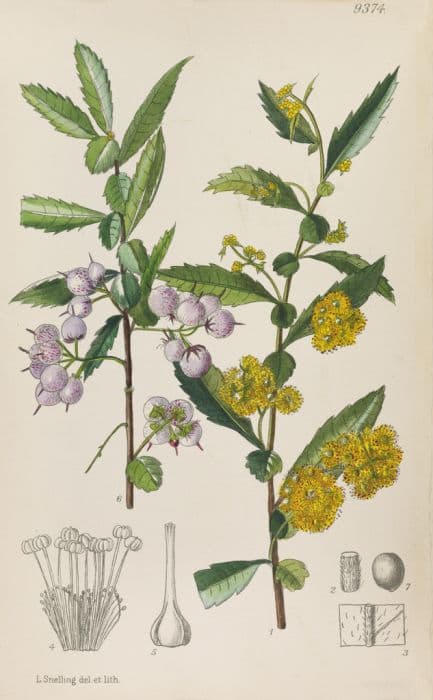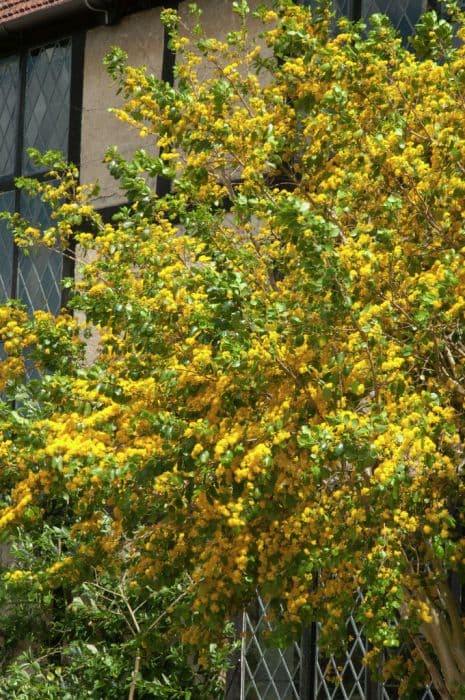Woolly willow Salix lanata

ABOUT
S. lanata is a bushy, slow-growing small deciduous shrub with rounded, silvery-woolly leaves to 6cm in length. Male catkins erect, to 5cm, silvery becoming yellow; female catkins longer, greenish
About this plant
 Names
NamesFamily
Salicaceae
Synonyms
Woolly Willow
Common names
Salix lanata.
 Characteristics
CharacteristicsLife cycle
Perennials
Foliage type
Deciduous
Color of leaves
Green
Flower color
Yellow
Height
3-6 feet (0.91-1.83 meters)
Spread
4-8 feet (1.22-2.44 meters)
Plant type
Shrub
Hardiness zones
2
Native area
Europe
Benefits
 General Benefits
General Benefits- Ecological importance: Salix lanata, commonly known as Woolly Willow, provides habitat and food for various wildlife, particularly insects and birds that depend on willow species.
- Erosion control: Due to its rooting pattern, Woolly Willow can help stabilize soil and prevent erosion in fragile environments.
- Landscaping: Its distinctive woolly leaves and growth habit can add a unique aesthetic to gardens and landscapes.
- Biomass production: Fast-growing willows like Salix lanata can be used for bioenergy or biomass due to their rapid growth and ease of cultivation.
- Soil improvement: Willows can enrich the soil by breaking up hard soils with their roots and improving soil structure through leaf litter decomposition.
- Windbreaks: When planted in rows or hedges, Woolly Willow can serve as a windbreak, protecting other plants and reducing wind erosion.
- Phytoremediation: Willows have the ability to absorb heavy metals and other contaminants from soil, making them useful for cleaning up polluted sites.
- Carbon sequestration: Like other fast-growing plants, Woolly Willow can capture and store carbon dioxide from the atmosphere, helping to mitigate climate change.
- Supporting biodiversity: Woolly Willow can be part of a diverse plant community that supports a wide range of organisms, contributing to overall biodiversity.
 Medical Properties
Medical Properties- Anti-inflammatory: Salix lanata contains salicin, which can be metabolized into salicylic acid in the body, known for its anti-inflammatory effects.
- Analgesic: The salicin in the plant may also act as a pain reliever for headaches and other aches and pains.
- Antipyretic: Salicylic acid derivatives from the plant have fever-reducing properties.
- Rheumatic Relief: Traditionally, it may have been used to treat rheumatic pain and other inflammatory conditions.
 Air-purifying Qualities
Air-purifying QualitiesThis plant is not specifically known for air purifying qualities.
 Other Uses
Other Uses- Woolly Willow twigs can be used for basket weaving due to their flexibility and strength. Weavers often value the plant for its unique texture and durability.
- The inner bark of Woolly Willow can serve as emergency food for survival situations. It is known to be scraped and eaten by indigenous people in times of scarcity.
- Leaves of Woolly Willow are sometimes used to stuff small pillows or sachets for their subtle fragrance and insulation properties.
- The plant's ability to grow in harsh, high-altitude environments makes Woolly Willow a good candidate for soil erosion control in alpine regions.
- Fiber from the bark of Woolly Willow can be transformed into a rudimentary paper or pulp for crafting in traditional or educational settings.
- Dye extracted from the leaves and bark of Woolly Willow can be used in natural fabric dying techniques, offering earth-toned colors.
- Woolly Willow branches are often incorporated into rustic furniture design, adding a natural and wild aesthetic to handmade pieces.
- Felted crafts can be embellished with Woolly Willow's catkins, providing a unique, natural decoration that adds texture and visual interest.
- In some cultures, Woolly Willow branches are used in ceremonies or rituals as symbols of resilience and adaptability due to their ability to thrive in tough climates.
- Young shoots of Woolly Willow can be used in floral arrangements and nature-inspired art installations for their soft, woolly appearance and pliability.
Interesting Facts
 Feng Shui
Feng ShuiWoolly willow is not used in Feng Shui practice.
 Zodiac Sign Compitability
Zodiac Sign CompitabilityWoolly willow is not used in astrology practice.
 Plant Symbolism
Plant Symbolism- Flexibility: The Salix genus, which includes willows, often represents flexibility due to their pliable branches that bend without breaking.
- Resilience: Willows are known for their ability to grow and even thrive in challenging conditions, symbolizing resilience and the ability to adapt.
- Grieving: In many cultures, willows are associated with sorrow and mourning, often found in literature and art as an emblem of grief.
- Protection: With its widespread roots and overarching canopy, the willow is sometimes seen as a symbol of protection and shelter.
- Healing: Historically, the bark of willow trees has been used for its medicinal properties, representing healing and the soothing of pain.
- Intuition: The willow is also linked with the moon and water, which in various mythologies are connected to intuition and deeper understanding.
- Renewal: Since willows can regenerate from a single fallen branch, they often symbolize renewal and the cycle of life.
 Water
WaterFor woolly willow, which is the most common name of Salix lanata, water deeply to ensure the soil is moist as it favors consistently damp soil conditions. During the growing season, water the woolly willow once a week with 1 to 2 gallons of water, depending on the size of the plant and the weather conditions. Reduce watering in the winter to once every two to three weeks, or as needed if the soil remains wet. Always check the soil moisture level before watering to avoid overwatering, which can lead to root rot.
 Light
LightWoolly willow thrives best in full sunlight to partial shade. Place it in a spot where it can receive at least six hours of direct sunlight daily, while providing some afternoon shade in hotter climates to prevent leaf scorch. Avoid deep shade as it may lead to sparse foliage and reduced vigor of the plant.
 Temperature
TemperatureWoolly willow prefers cooler climates and is hardy in a range between -20°F to -30°F up to 70°F. It can tolerate temporary dips as low as -50°F. The ideal temperature for woolly willow to thrive is between 50°F and 65°F, which promotes healthy growth without stressing the plant.
 Pruning
PruningPrune woolly willow in late winter or early spring before new growth begins to maintain shape and encourage healthy new branches. Remove any dead, damaged, or diseased wood, as well as any branches that are crossing or rubbing against each other. Pruning can be done annually, and it’s also an opportune time to shape the plant or manage its size.
 Cleaning
CleaningAs needed
 Soil
SoilWoolly willow prefers a well-draining soil mix rich in organic matter, with a slightly acidic to neutral pH of 5.5 to 7.0. A mixture of peat, loam, and sand can provide the necessary drainage and fertility.
 Repotting
RepottingWoolly willow does not typically require frequent repotting. It should be repotted every two to three years or when it outgrows its current pot, ensuring minimal root disturbance.
 Humidity & Misting
Humidity & MistingWoolly willow thrives in moderate to high humidity levels but is adaptable and can tolerate lower humidity environments without issue.
 Suitable locations
Suitable locationsIndoor
Place woolly willow in bright indirect light with cool temperatures.
Outdoor
Plant woolly willow in partial shade, keep soil moist.
Hardiness zone
4-8 USDA
 Life cycle
Life cycleWoolly Willow begins its life cycle as a seed, which after dispersal often by wind or water, germinates in moist soil conditions during spring. The seedling then establishes a root system and begins to grow vertically, forming a small woody shrub with characteristic woolly, dense foliage. This deciduous shrub experiences seasonal growth, with leaves and catkins—male and female reproductive structures—emerging in the spring. Pollination occurs typically through wind or insect activity, leading to the development of fruits containing seeds. After the growing season, Woolly Willow enters a period of dormancy during the winter, shedding its leaves. Over successive years, the plant matures, continually reproducing through seeds and sometimes vegetatively through root suckers, and can live for several decades under the right environmental conditions.
 Propogation
PropogationPropogation time
Spring-Early Summer
Woolly willow, or Salix lanata, can be propagated most popularly through the method of stem cuttings. This practice is typically done in late winter to early spring when the plant is still dormant. Healthy, pencil-sized branches from last year's growth are cut into lengths of about 6 to 9 inches (15 to 23 centimeters), ensuring that each cutting has several nodes. Cuttings are then inserted into a well-draining rooting medium, such as a mix of sand and peat, with about two-thirds of their length beneath the surface. The medium is kept moist but not waterlogged, and the cuttings are placed in a warm, indirect light area until roots develop, which generally takes a few weeks. Once rooted, the young willows are potted or planted in their final location.









